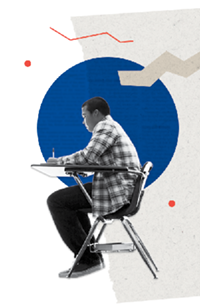I begin with the presentation of four facts. First, higher education institutions in the United States were not built for people of color. Instead, profits from slavery, as well as the actual labor of enslaved African people, were used to build many of our nation’s early colleges and universities. Second, when Black collegians were afforded access to what Prisca Dorcas Mojica Rodriguez and Aireale J. Rodgers call “white-serving institutions” (WSIs), their entry was almost always met with opposition, violence, and isolation. The majority of campuses that the first Black students entered prior to 1970 had no Black faculty, no Black history, no Black culture, no Black anything. The third fact is that WSIs have excluded students of color far longer than they have included them in any meaningful or measurable way. Some institutions are more than 300 years old—for 200 or more of those years, they only admitted and graduated students who were white. Fourth, the most significant racial breakthroughs in the history of American higher education were born of student protests.
The Student Nonviolent Coordinating Committee (SNCC) and other activist groups led a wave of campus uprisings in the 1960s that began to disrupt the exclusive, often violent, nature of WSIs. The Black Student Union and a coalition of other student groups known as the Third World Liberation Front (TWLF) orchestrated sit-ins and other demonstrations at San Francisco State University; the outcome was the birth of Black Studies on that campus and gradually elsewhere across the country. Chicanx, Asian American, Pacific Islander, and Black students stood in solidarity as they demanded that the curriculum at the University of California–Berkeley include their cultural histories and lives. Culture centers that still stand at WSIs were on lists of demands that student activists presented to their campus leaders three to four decades prior. Also, throughout the 1960s, students on the campuses of historically Black colleges and universities (HBCUs) were protesting racism and social injustice in the larger society.
I am not so sure that WSIs and the rest of higher education realize how indebted we all are to student activists and their supporters. There would be significantly fewer students, faculty, and administrators of color had protesters not demanded it. On some campuses, there would still be none. There would be no ethnic studies or ethnic culture centers. And the mainstream curriculum would likely include only Eurocentric and white American cultural perspectives. These suppositions of mine are informed largely by contemporary realities. Although previous generations of courageous student agitators have fought for these advances, they still remain obviously unimportant to the overwhelming majority of trustees, administrators, and faculty members at many WSIs.
Truth is, boards of trustees are about 75 percent white at public institutions and 87 percent white at private ones.1 Eighty-three percent of college and university presidents are white.2 This number is even higher when chief executives from HBCUs, Hispanic-serving institutions, and community colleges (which enroll a disproportionately high share of students of color in US higher education) are excluded. Seventy-five percent of full-time faculty members are white.3 Again, this number is higher at WSIs. On some campuses, African American Studies majors, minors, and programs were recently elevated to academic departments, mostly as a result of campus uprisings during the 2015–2016 academic school year. This is commendable. But the reality on lots of other campuses is that ethnic studies remain on the periphery, with a pathetically small number of full-time faculty and too few institutional resources. Moreover, ethnic culture centers and multicultural centers are located in raggedy buildings on the outskirts of campus, in dark basements of old buildings, and in tiny office suites that are incapable of accommodating more than a dozen students of color at one time. These are among the shortcomings of WSIs that activists are protesting in the modern era.
In addition to structural and systemic reminders of their unimportance, contemporary college students of color are also resisting commonplace encounters with racism and racial stress on their campuses. Researchers in the centers I founded at the University of Pennsylvania and the University of Southern California have conducted face-to-face interviews with more than 10,000 undergraduates in every geographic region of the United States. Participants in our campus racial climate studies, many of whom are students of color, recalled for us numerous examples of horrifying racial violence at WSIs. For instance, on all but one campus where we have done this research, at least one Black student had been called a “nigger” by a white peer, professor, or faculty member. At other institutions, students of color had been racially profiled by campus police officers. White people called the police on tuition-paying Black collegians because they presumed them to be criminal outsiders who had come to inflict violence on campus.
In 2019, many students of color continue to be the only persons from their racial and ethnic groups in most classes they take at WSIs. Too many of them have told us that their classmates and instructors make racially offensive remarks in class without consequence; they expect the lone student of color to speak on behalf of all people of color in class discussions; and they are surprised when the one Latinx woman writes well or thoughtfully contributes. Furthermore, they assume the one Latinx man is an undocumented American and the Black woman was only admitted because of affirmative action—hence, they do not deserve to be there. Black men are commonly presumed to be student-athletes and are treated in accordance with the “dumb jock” stereotype. Asian American, Pacific Islander, Native American, and multiracial students experience extreme invisibility and erasure; few campuses take the time to understand what their needs, issues, experiences, and expectations are.
At this point, I have several hundred examples of racial problems and occurrences that compel college students of color and their supporters to demand institutional change. These examples are from my research, studies that other scholars have published over the past 60 years, and other sources. During the 2016, 2017, and 2018 academic school years, Diverse Issues in Higher Education, Inside Higher Ed, and The Chronicle of Higher Education published nearly 400 news stories about racial incidents on campuses across the country. Few of those situations and tragedies surprised me, as they are fully consistent with what I have been hearing for years in my interviews with students of color about their experiential realities at WSIs.
Because of their extraordinary contributions to racial progress in American higher education, I deeply respect and admire college student activists. But unfortunately, most campus administrators fear them. They want uprisings to quickly deflate and campuses to return to normal. What they do not realize is that “normal” is racist, exclusionary, offensive, and sometimes violent. It is not as clear to them as it is to me that students of color and their supporters are resisting everyday racism while putting their bodies and academic lives on the line to improve WSIs for themselves and future generations. Campus leaders also routinely fail to realize how uprisings help actualize the rhetoric concerning equity, diversity, and inclusion espoused in presidential speeches, in admissions brochures, on university websites, and elsewhere. That is, activists help hold administrators and faculty members at WSIs accountable for becoming what they claim to be. These campus leaders rarely choose to acknowledge what I and several others know is true: WSIs will continually uphold white supremacy if frustrated students of color and others discontinue their activist efforts. For this reason, I will forever be a huge appreciator and proponent of campus uprisings. I am grateful to Professors Douglas, Shockley, and Toldson, as well as their brilliant cast of authors, for producing this timely book on the topic. I have an even greater appreciation for the members of SNCC, TWLF, and other activist groups, as well as those who have advanced the Black Power, Black Lives Matter, and ‘me too’ movements at colleges and universities across the country. Uprisings they led made campuses better, more diverse, more inclusive, more responsive, and more accountable.
Shaun R. Harper is Provost Professor of Management and Organization, Clifford and Betty Allen Chair in Urban Leadership, and University of Southern California Race and Equity Center executive director. An author and researcher, he studies racial, gender, and LGBTQ issues in corporations, law firms, Hollywood production companies, K–12 schools, and universities.
This adapted selection is reprinted by permission of the Publisher. From Ty-Ron M. O. Douglas, et al., eds., Campus Uprisings: How Student Activists and Collegiate Leaders Resist Racism and Create Hope, New York: Teachers College Press. Copyright © 2020 by Teachers College, Columbia University. All rights reserved.
To read more from Campus Uprisings, see "Introducing Campus Uprisings" and "Preparing for Racial Unrest on Campus."
Endnotes
1. Citizen Trustee Survey: Selected Results and Analysis (Washington, DC: Association of Community College Trustees, October, 2018) https://www.acct.org/files/Publications/2018/Citizen%20Trustee/Citizen_…; P. Fain, “Diversity Remains Fleeting on Colleges’ Governing Boards, Survey Finds,” Chronicle of Higher Education, November 29, 2010, https://www.chronicle.com/article/Diversity-Remains-Fleeting-on/125566.
2. Minority Presidents Profile: American College President Study (Washington, DC: American Council on Education’s Center for Policy Research and Strategy, 2017) https://www.aceacps.org/minority-presidents/.
3. B. Hussar et al., Condition of Education 2020 (Washington, DC: U.S. Department of Education, National Center for Education Statistics, 2020) 150-153, https://nces.ed.gov/programs/coe/pdf/coe_csc.pdf.
[Illustrations by Lucy Naland, photos: courtesy Walter P. Reuther Library / Flip Schulke - Black Star; Collection of the Smithsonian National Museum of African American History and Culture; Nacio Jan Brown; Getty Images]



